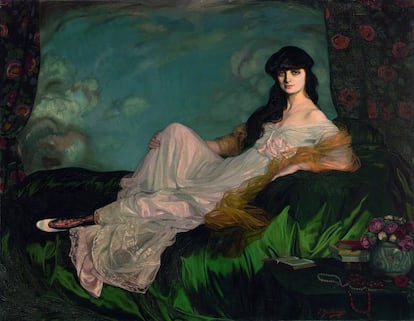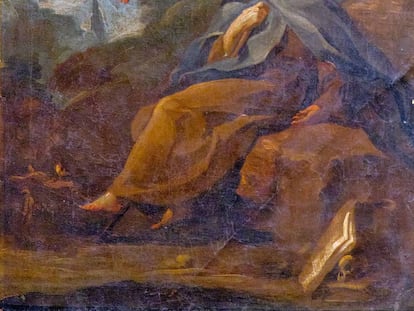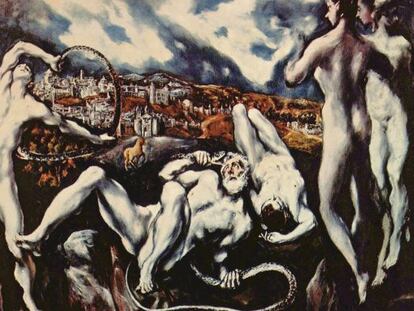Zuloaga: more than just a painter of Spanish clichés
Mapfre Foundation shines new light on artist with exhibition including works by Picasso and Rodin
European modernity or Celtiberian spirit? Symbolism or cliché? Parisian countesses or village bull run? Upbeat Belle Époque or grim generation of ’98? According to the Mapfre Foundation’s Madrid exhibition Zuloaga in Belle Époque Paris 1889–1914, Zuloaga was all of the above. And by placing the Basque artist within the context of friends and colleagues from that period, it aims to offer a fresh view of the painter who is regularly relegated by art historians to the generation of 98 and to the realm of España Negra, or deep Spain.

With 90 works of art, the exhibition’s curators Pablo Jiménez Burillo and Leyre Bozal are keen to boost the painter’s popularity. “We’ve always had trouble with [Zuloaga] in Spain as he has often been seen as a Spanish artist painting Spanish clichés and we don’t really like him,” says Jiménez Burillo.
In one of the few exhibitions to be held on Zuloaga in Spain, the curators wanted to highlight the idea that while the debate raged about the different Spains – the exotic, the backward, the ecstatic monks – Ignacio Zuloaga had mesmerized half of Europe, particularly the French.

Above all, Zuloaga was a master of his art, particularly when it came to capturing the essence of a person in his portraits and group scenes. But he has paid dearly for his paintings of dwarfs, ‘madams,’ beggars and peasants in traditional dress that compounded the image of a backward country in comparison to the rest of Europe. His support of Franco also detracted from his popularity.
But while these aspects of the painter existed and were of course applauded by some, there was also the other Zuloaga – the man whose culture was both Spanish and French, the painter who could change his register on demand, who traveled widely and consorted with the intellectual and artistic elite of Paris between 1889 and 1914 when the First World War transformed the landscape.
While previous exhibitions have sought to rekindle interest in Zuloaga –the Mapfre Foundation held one that combined his works with those of Sorolla in 1998 and, in 2015, the Sala Centro in Cibeles held another that illustrated his friendship with Manuel de Falla – Zuloaga in Belle Époque Paris 1889-1914 is perhaps the most ambitious yet, drawing as it does from various domestic and international private collections and galleries all over the world, including institutions in Venice, Paris, Boston and Moscow among others.
Picasso’s Celestina returns to Spain
One of the jewels of Zuloaga in Belle Époque Paris 1889-1914 is, without a doubt, La Celestina by Pablo Picasso painted in 1903, usually on display at the Musée Picasso in Paris. An example of the artist's Blue Period, its only other visit to Spain was in 2003 when the Museo Picasso was opened in Malaga.
Picasso's oil canvas of an angular, one-eyed woman – donated to the Paris gallery in 1989 by the Swedish art collector Fredrik Roos – hangs close to Zuloaga's Celestina which was painted two years later and regularly hangs in the Reina Sofia museum in Madrid.
There is a stark contrast between the two. While Picasso's Celestina portrays a prostitute from the lower classes, distressed and oppressed, Zuloaga's Celestina is surrounded by rich detail. Picasso's woman fills the canvas while Zuloaga's prostitute is sitting at a dressing table draped in a luxurious cape in a large room, waiting languidly for her next customer.
As the curator Leyre Bozal says in the exhibition catalogue, “It looks more like one of Toulouse-Lautrec’s Parisian bordellos than a brothel in a Spanish village.”
The exhibition is on until January 7, 2018.
The exhibition is divided into sections: the artist’s early years; Zuloaga’s Paris; Zuloaga and his closest friends, Émile Bernard and Auguste Rodin; Zuloaga the portrait painter; his view of Spain; and the return to his roots. The artist’s own work is placed in context by hanging it alongside the works of his friends and mentors such as Toulouse-Lautrec, Gauguin, Rodin and Picasso. One room is filled with the works of Spanish artists collected by Zuloaga including El Greco, Zurbarán and two prints from Goya’s Disasters of War series.
Zuloaga’s Parisian portraits as well as his depiction of Spain as a country of priests and bulls, dwarfs, village mayors, and mangy dogs show influences of symbolism picked up in Paris, which is also evident in his portrayal of Segovia and Avila countryside and in paintings such as The Mayor of Torquemada, Preparations for the Bull Run, The Women of Sepúlveda, and The Dwarf and Cobbler Gregorio, and above all in his portrait of the novelist and deputy of the French Third Republic Maurice Barrès in Toledo: in short, the exhibition merges the French and Spanish Zuloaga.
One word about lighting at the exhibition– it was so poor that to avoid disruptive reflection, the paintings had to be viewed close-up. One can only suppose that this problem will be addressed.
English version by Heather Galloway.
Tu suscripción se está usando en otro dispositivo
¿Quieres añadir otro usuario a tu suscripción?
Si continúas leyendo en este dispositivo, no se podrá leer en el otro.
FlechaTu suscripción se está usando en otro dispositivo y solo puedes acceder a EL PAÍS desde un dispositivo a la vez.
Si quieres compartir tu cuenta, cambia tu suscripción a la modalidad Premium, así podrás añadir otro usuario. Cada uno accederá con su propia cuenta de email, lo que os permitirá personalizar vuestra experiencia en EL PAÍS.
¿Tienes una suscripción de empresa? Accede aquí para contratar más cuentas.
En el caso de no saber quién está usando tu cuenta, te recomendamos cambiar tu contraseña aquí.
Si decides continuar compartiendo tu cuenta, este mensaje se mostrará en tu dispositivo y en el de la otra persona que está usando tu cuenta de forma indefinida, afectando a tu experiencia de lectura. Puedes consultar aquí los términos y condiciones de la suscripción digital.
More information
Archived In
Últimas noticias
The complicated life of Francesca Albanese: A rising figure in Italy but barred from every bank by Trump’s sanctions
Half of Scotland is in the hands of 420 property owners
Reinhard Genzel, Nobel laureate in physics: ‘One-minute videos will never give you the truth’
Pinochet’s victims grapple with José Antonio Kast’s rise in Chile
Most viewed
- Pablo Escobar’s hippos: A serious environmental problem, 40 years on
- Why we lost the habit of sleeping in two segments and how that changed our sense of time
- Charles Dubouloz, mountaineering star, retires at 36 with a farewell tour inspired by Walter Bonatti
- Trump’s obsession with putting his name on everything is unprecedented in the United States
- The Florida Keys tourist paradise is besieged by immigration agents: ‘We’ve never seen anything like this’











































